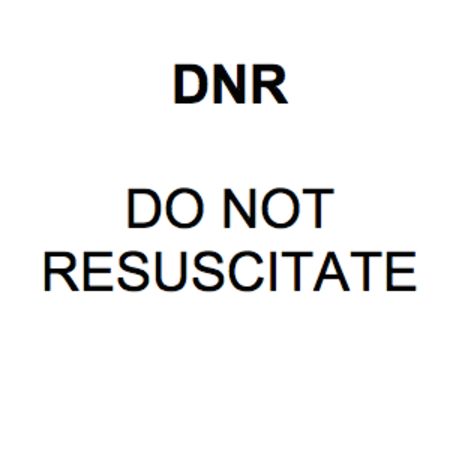Do-not-resuscitate (DNR) orders are often established for patients whose prognosis is poor. Now new research published in JAMA finds that almost two-thirds of patients with the worst prognosis after in-hospital cardiac arrest did not have DNR orders.
“Among patients with a low likelihood of favourable neurological survival after in-hospital cardiac arrest, our findings highlight the potential to improve DNR decision making,” write Timothy J. Fendler, MD, MS, of Saint Luke’s Mid America Heart Institute (Kansas City), and co-authors.
From a registry (Get With The Guidelines-Resuscitation), the researchers identified 26,327 patients with return of spontaneous circulation (ROSC) after in-hospital cardiac arrest between April 2006 and September 2012 at 406 U.S. hospitals. The team used a previously validated prognostic tool to assess each patient's likelihood of favourable neurological survival — ie, without severe neurological disability. They also examined the proportion of patients with DNR orders within each prognosis score group and the association between DNR status and actual favourable neurological survival. The results showed that:
“In this national registry of in-hospital cardiac arrest, we found that DNR orders after successful resuscitation were generally aligned with patients’ likelihood for favourable neurological survival, with increasing rates of DNR orders as a patient’s likelihood to survive without neurological disability decreased," the authors explain. "Nevertheless, almost two-thirds of patients with the worst prognosis did not have DNR orders, even though only 4.0 percent of patients within this [group] had favourable neurological survival."
In an accompanying editorial, Derek C. Angus, MD, MPH, of the University of Pittsburgh, and Associate Editor, JAMA, writes: "[A]fter successful ROSC, just as after the initial response to any disaster, it is clear the work has only just begun. Hopefully in the future, standardised delivery of high-quality evidence-based resuscitation guidelines for cardiac arrest will be followed by equally high-quality standard approaches to ensure patients and families are supported optimally, regardless of prognosis.”
In comments to ICU Management Prof. Angus said he was surprised that most DNR orders were within 12 hours of ROSC. "I would have thought that the clinicians and families would need some time to get together, process the new information about change in prognosis, and come to a decision to change goals of care from full and aggressive care to DNR," he pointed out. "Therefore, I thought that, in many instances, if DNR orders were to be initiated, they would take a couple of days."
Prof. Angus' interview with first author Dr. Fendler will be available via the JAMA website.
Source: JAMA
Image credit: Wikimedia Commons
“Among patients with a low likelihood of favourable neurological survival after in-hospital cardiac arrest, our findings highlight the potential to improve DNR decision making,” write Timothy J. Fendler, MD, MS, of Saint Luke’s Mid America Heart Institute (Kansas City), and co-authors.
From a registry (Get With The Guidelines-Resuscitation), the researchers identified 26,327 patients with return of spontaneous circulation (ROSC) after in-hospital cardiac arrest between April 2006 and September 2012 at 406 U.S. hospitals. The team used a previously validated prognostic tool to assess each patient's likelihood of favourable neurological survival — ie, without severe neurological disability. They also examined the proportion of patients with DNR orders within each prognosis score group and the association between DNR status and actual favourable neurological survival. The results showed that:
- Overall, 5,944 patients (23 percent) had DNR orders within 12 hours of ROSC.
- Among patients with the best prognosis, 7 percent had DNR orders although their predicted rate of favourable neurological survival was 65 percent.
- Among patients with the worst prognosis, 36 percent had DNR orders even though their predicted rate for favourable neurological survival was 4 percent.
- The actual rate of favourable neurological survival was higher for patients without DNR orders (31 percent) than it was for those with DNR orders (2 percent).
“In this national registry of in-hospital cardiac arrest, we found that DNR orders after successful resuscitation were generally aligned with patients’ likelihood for favourable neurological survival, with increasing rates of DNR orders as a patient’s likelihood to survive without neurological disability decreased," the authors explain. "Nevertheless, almost two-thirds of patients with the worst prognosis did not have DNR orders, even though only 4.0 percent of patients within this [group] had favourable neurological survival."
In an accompanying editorial, Derek C. Angus, MD, MPH, of the University of Pittsburgh, and Associate Editor, JAMA, writes: "[A]fter successful ROSC, just as after the initial response to any disaster, it is clear the work has only just begun. Hopefully in the future, standardised delivery of high-quality evidence-based resuscitation guidelines for cardiac arrest will be followed by equally high-quality standard approaches to ensure patients and families are supported optimally, regardless of prognosis.”
In comments to ICU Management Prof. Angus said he was surprised that most DNR orders were within 12 hours of ROSC. "I would have thought that the clinicians and families would need some time to get together, process the new information about change in prognosis, and come to a decision to change goals of care from full and aggressive care to DNR," he pointed out. "Therefore, I thought that, in many instances, if DNR orders were to be initiated, they would take a couple of days."
Prof. Angus' interview with first author Dr. Fendler will be available via the JAMA website.
Source: JAMA
Image credit: Wikimedia Commons
References:
Fendler TJ, Spertus JA, Kennedy KF et al. (2015) Alignment of Do-Not-Resuscitate status with patients’ likelihood of favorable neurological survival after in-hospital cardiac arrest. JAMA, 314(12):
1264-71.
Angus DC (2015) Successful resuscitation from in-hospital cardiac arrest - what happens next? JAMA, 314(12): 1238-9.
Angus DC (2015) Successful resuscitation from in-hospital cardiac arrest - what happens next? JAMA, 314(12): 1238-9.
Latest Articles
healthmanagement, cardiac arrest, do-not-resuscitate order, DNR, resuscitation, JAMA
Do-not-resuscitate (DNR) orders are often established for patients whose prognosis is poor. Now new research published in JAMA finds that almost two-thirds of patients with the worst prognosis after in-hospital cardiac arrest did not have DNR orders.



























